I collected qualitative data and analysed it using Interpretative Phenomenological Analysis (IPA). But how did I actually do it? This post is about my experience of doing IPA.
IPA is a really in-depth qualitative analytic method. The end result in the thesis or what is published is only a summary of the whole analytic story. I previously shared a time lapse on Twitter which was a snapshot of my IPA journey. Although I can’t really explain thinking process and analysis itself, hopefully this post will give you a better idea of what the analysis process looked like and the steps involved.
Briefly, what is IPA?
Interpretative Phenomenological Analysis (IPA) is a methodology for qualitative data collection and analysis. It’s an approach often used to explore how people make sense of life experiences.
IPA is underpinned by philsophy, including phenomenology, hermeneutics, and idiography (aka big words). So, if you want to read more about this, I would highly recommend the book Interpretative Phenomenological Analysis: Theory, Method and Research (2nd Ed.) by Smith, Flowers and Larkin**. I followed the analysis steps in the Smith, Flowers and Larkin book, but not necessarily in a linear order.
**Note about the book: there is now a second edition, which has slightly different terminology to the first. I started with the first book, but switched to 2nd edition terminology for writing up as they make more sense to me. Therefore, if you know IPA already, you will notice the terminology difference.
In my research, I explored how people with Chronic Obstructive Pulmonary Disease (COPD) made sense of their experiences of using apps and/or wearables for monitoring physical activity. This research follows on from my published Scoping Review of the literature.
I collected my data from interviews with 7 people with COPD talking with them about their experiences of using apps and wearables for monitoring their activity. I analysed each interview in depth first before looking at similarities and differences between them.
Practically, how I did the analysis
I was extremely anxious about starting the actual analysis. I’d read all about IPA and the steps to go through, but when it came to actually doing it I had no idea where to start. This is where I have to thank to Esme Wood for sharing her experiences with me about doing IPA for her PhD thesis, otherwise I don’t know what I would have done!
Step 1: Read, Read, Read… and make some notes
So, after transcribing and printing the transcript, I read and re-read it armed with my highlighters, coloured pens, post-it notes and the transcripts.
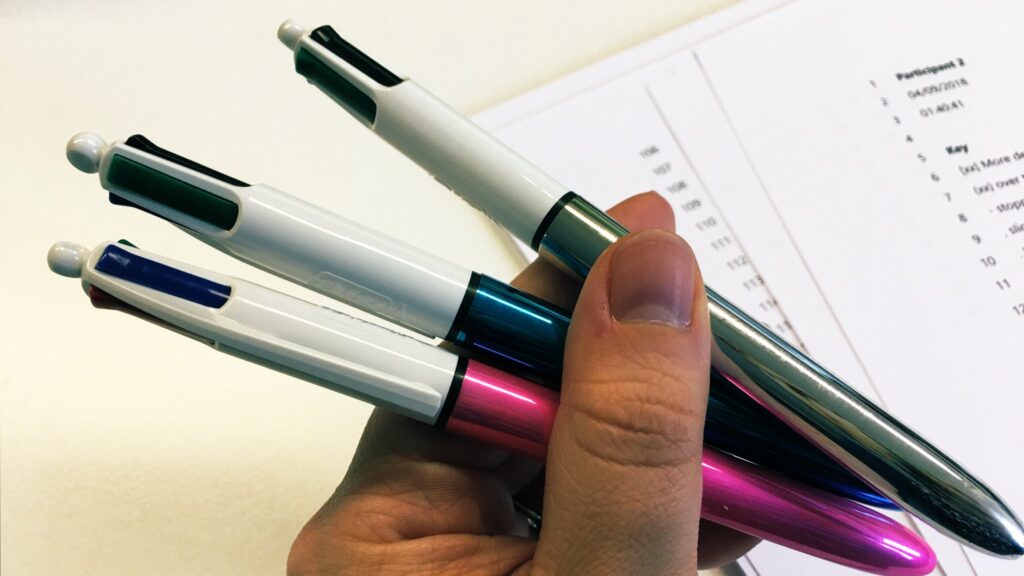
On the printed transcript with wide margins, I made initial ‘Exploratory notes’ on the right-hand side. These were in different colours to represent the descriptive (red), linguistic (blue) and conceptual (green) notes I was making. These notes were mostly initial thoughts about what the participant was saying, the meaning they were suggesting and my understanding of it. So red (descriptive) were more descriptions of what the participants were saying, blue (linguistic) where it was about the language or specific words they were using, and green (conceptual) if it was around overall concepts or psychological aspects.
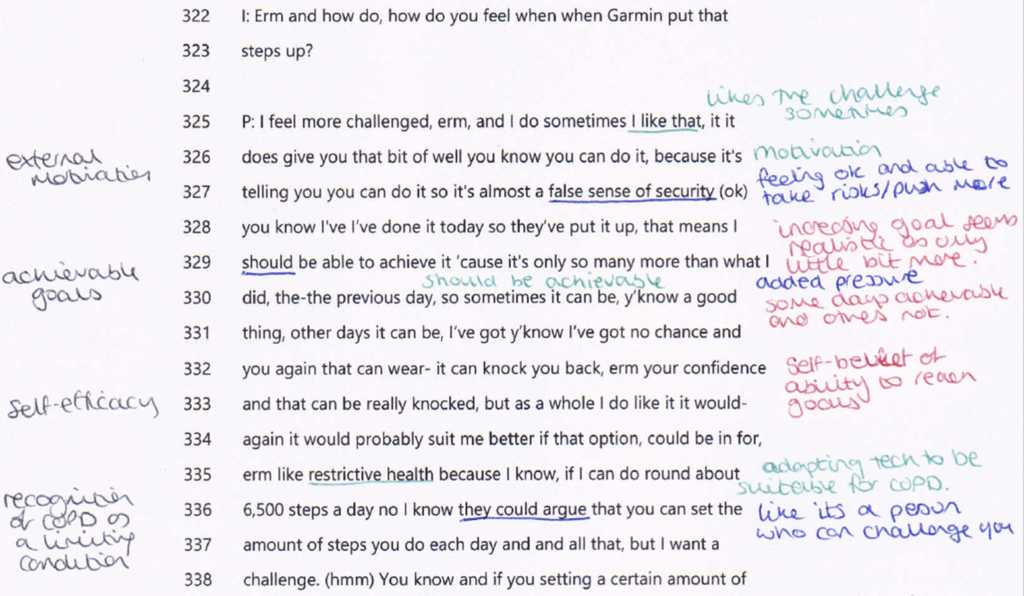
This distinction of noting is discussed more in the first IPA book, compared to the second edition. Sometimes I felt the different types of notes were not really that important. However, the different coloured notes were useful to think about different aspects of the transcript and have a more analytical view. I would often think “this page of transcript is all red, I need some blue or green notes here”. So, I would take another look and think about things like the language, or the psychological concepts that were there.
Step 2: Creating ‘Experiential statements’ from the ‘Exploratory notes’
Next, I started to sum up the participants experiences and my analytical notes by creating ‘Exploratory notes’ on the right hand side of the transcript (in black pen). These were almost like pre-themes, where I was summarising the notes on the right and the transcript, often these were repeated throughout the transcript where similar ideas were coming through.
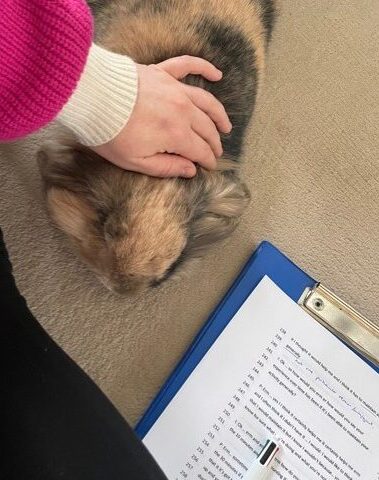
Step 3: Cut, organise and create piles of ‘Personal Experiential Themes’
After going over and over the transcript creating ‘Exploratory notes’ and ‘Experiential statements’ it was time to categorise and develop the ‘Personal experiential themes’ for the transcript.
As there was even more data now compared to when I started (from adding comments and notes), I was quite overwhelmed. The only way for me to do this, was to photocopy my transcript and cut it up into sections of ‘Experiential statements’ so I can see the quotes and my notes.

Cut up transcript ready for creating ‘Personal Experiential Themes’ 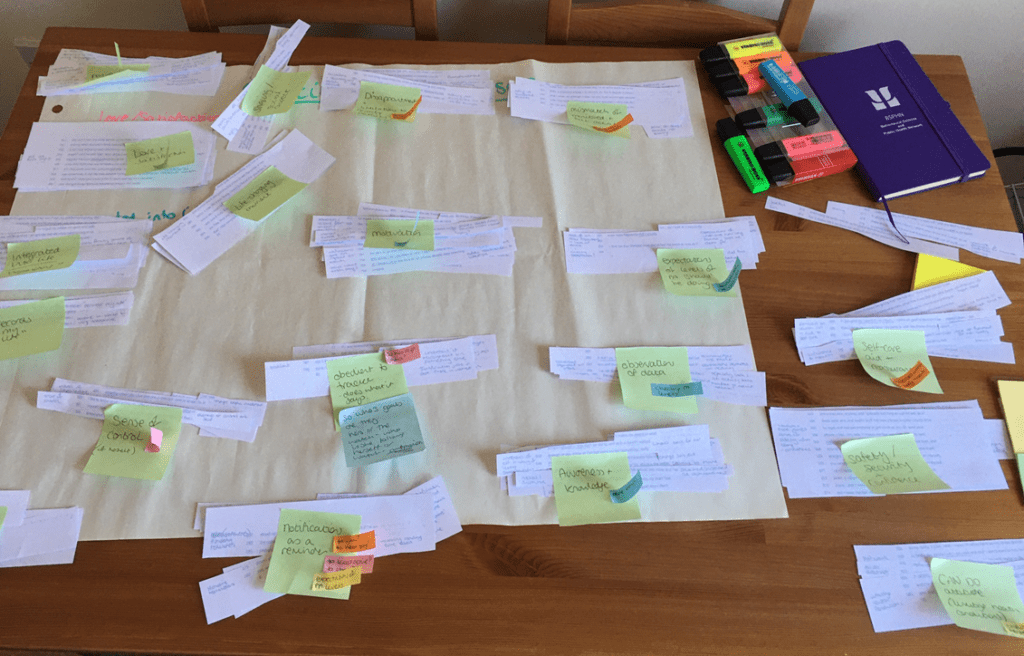
Little piles of ‘Personal Experiential Themes’
Eventually, I get to some nice piles of paper with post-it’s of ‘Personal experiential themes’ and subthemes. I wrote these up into a thematic table in a word document with the themes, subthemes and line numbers.

Step 4: Repeat with another transcript
Yep, do it all over again with another transcript. Read, read, read, add exploratory notes, create ‘experiential statements’ and then ‘personal experiential themes’… IPA is not a fast process!
Step 5: Look at ALL the analysed transcripts and create ‘Group Experiential Themes’
Once I analysed all 7 transcripts, I couldn’t remember what I had done with the first one… So I re-read them all, had a look at their themes and printed all the thematic tables for each participant. Of course, I cut these up too. I created little piles of ‘Group experiential themes’ subthemes and to see similarities and differences.
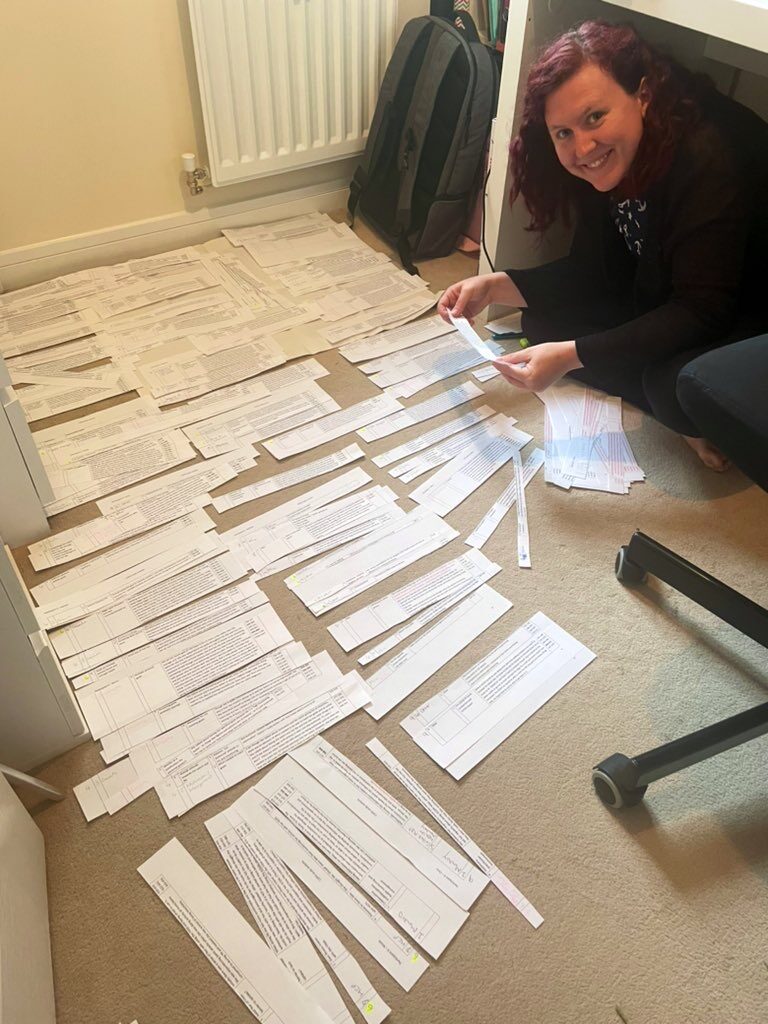
Caught by my Husband wondering why I am sat under my desk 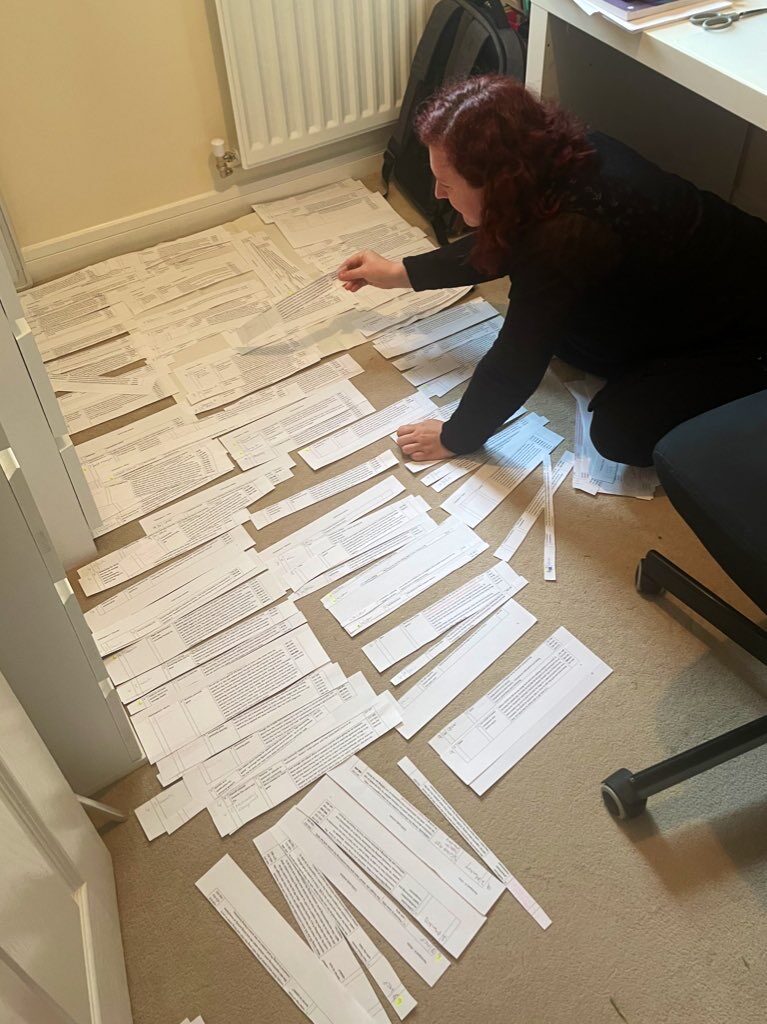
Creating ‘Group Experiential themes’ and running out of space 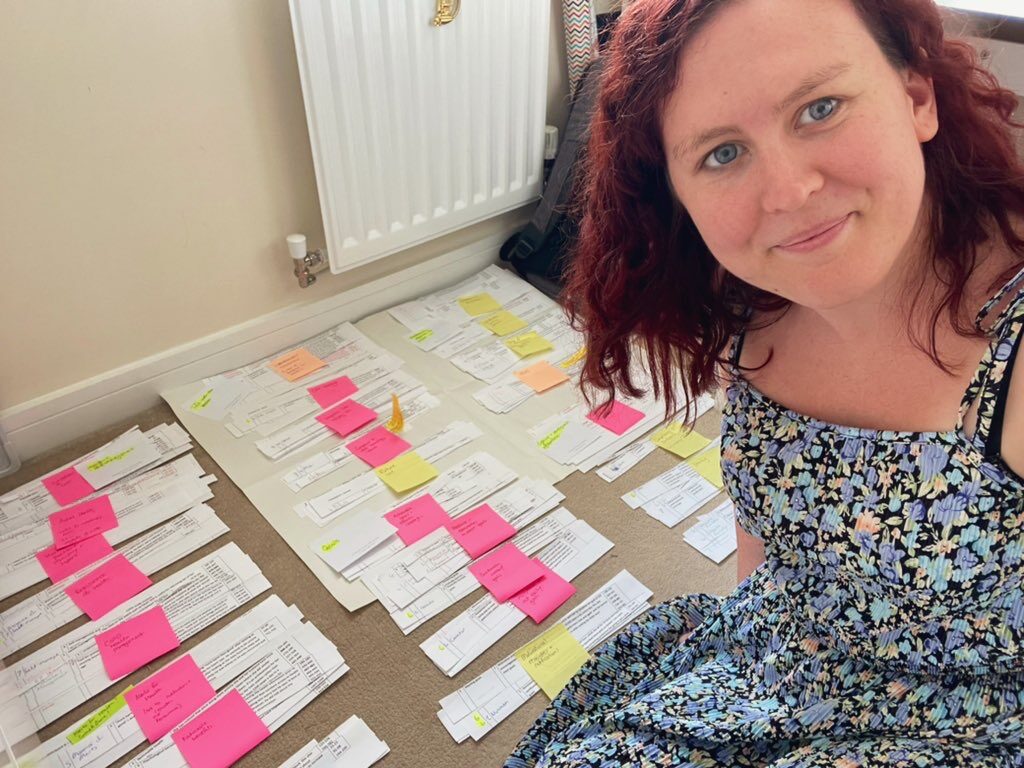
Fewer piles of ‘Group Experiential Themes’ and subthemes
I can’t lie, this took a long time and was still only the start of the overall analysis process. I was constantly looking at the piles of paper, reorganising and going back to the transcripts. An important part of IPA analysis is the interpretation, yet I wanted to stay grounded within the data and the participants experiences.
Eventually I ended up creating another table in word with the overall ‘Group Experiential Themes’ and subthemes, and corresponding ‘Personal Experiential Themes’ from each participant.
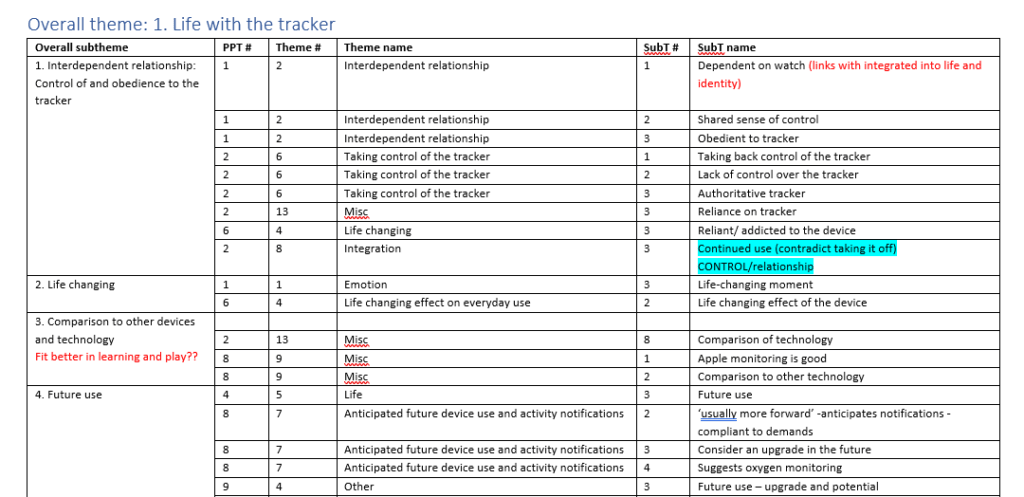
Step 6: Write, re-write, re-name themes, and re-organise
Now I had my initial ‘Group Experiential Themes’ and subthemes I started to write it up for my thesis. The analysis didn’t stop here though. As I was writing, I was revising the themes, their names and moving quotes around to see where they best fit and made sense. The write up is so important to be able to get all the analysis and thoughts in your brain out on paper so other people can read and make sense of it (no pressure!). I went through various revisions of my findings and gathered thoughts from my supervisors. Sharing drafts with my supervision team was really useful. It helped to get fresh eyes on the analysis as well as take a step back and think about the overall picture.
I feel like my findings are in a good place for my thesis now. I am looking forward to being able to share it with you all at some point!
Reflections
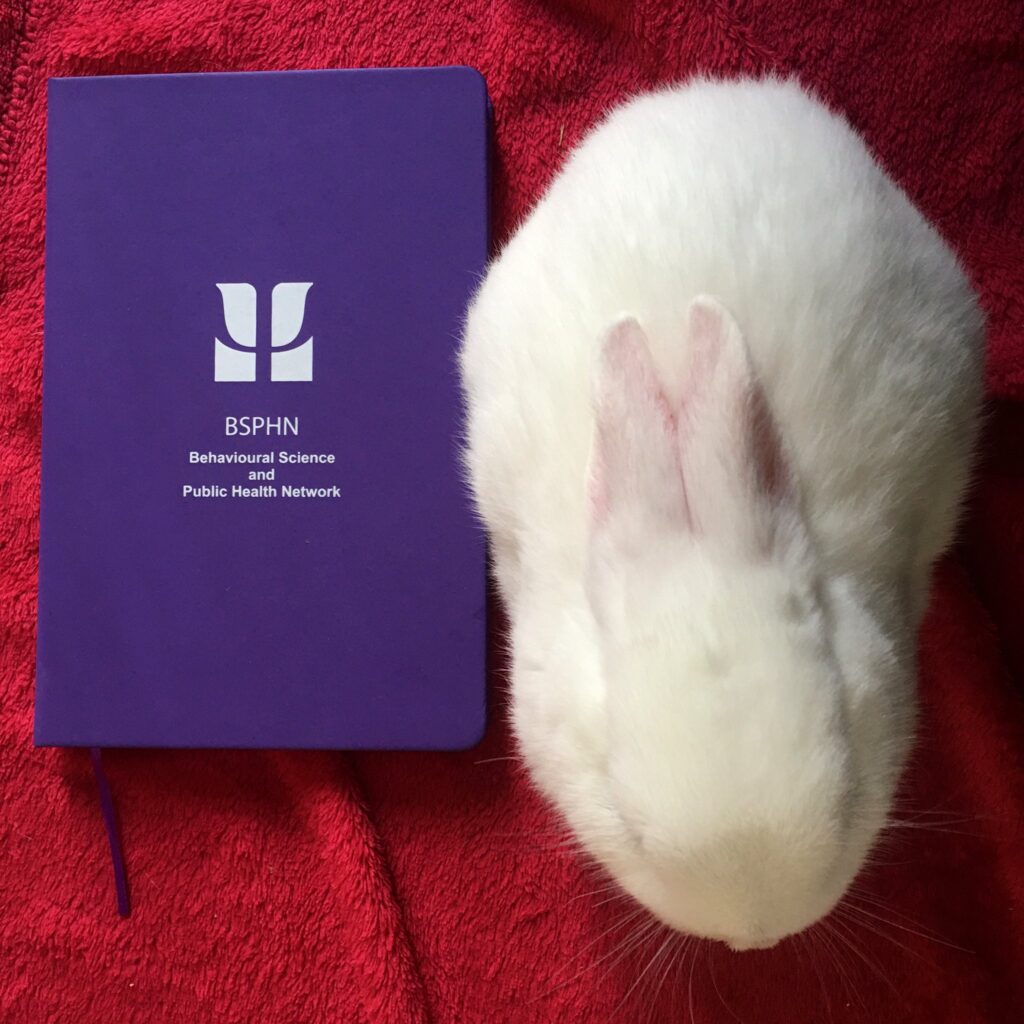
Throughout my analysis I was constantly reflecting and ‘bracketing’ in my little purple notebook, basically being mindful and aware of my thoughts and reactions to the data and analysis. I was making notes of thoughts, rather than shutting them out and ignoring them. We are human after all, so we can’t isolate each transcript and our experiences. Of course, as I analysed more and more, I thought about previous analysis and how they connected. Naturally, the more I analysed, the more thoughts I had. So, I made a note of them to go back to later.
Good enough for IPA?
When I first started my analysis, I was really worried if I would be able to get the in-depth data to do IPA, if I was being interpretative enough, and sometimes if I should have done Thematic Analysis.
It all worked out just fine, so far anyway – it still needs peer-reviewing and examining (yikes)! It was all a huge learning experience and I am so glad I did it. I did a lot of reading in advance and talked to other researchers who had done IPA. My supervisors were also excellent at supporting me and sharing ideas and thoughts.
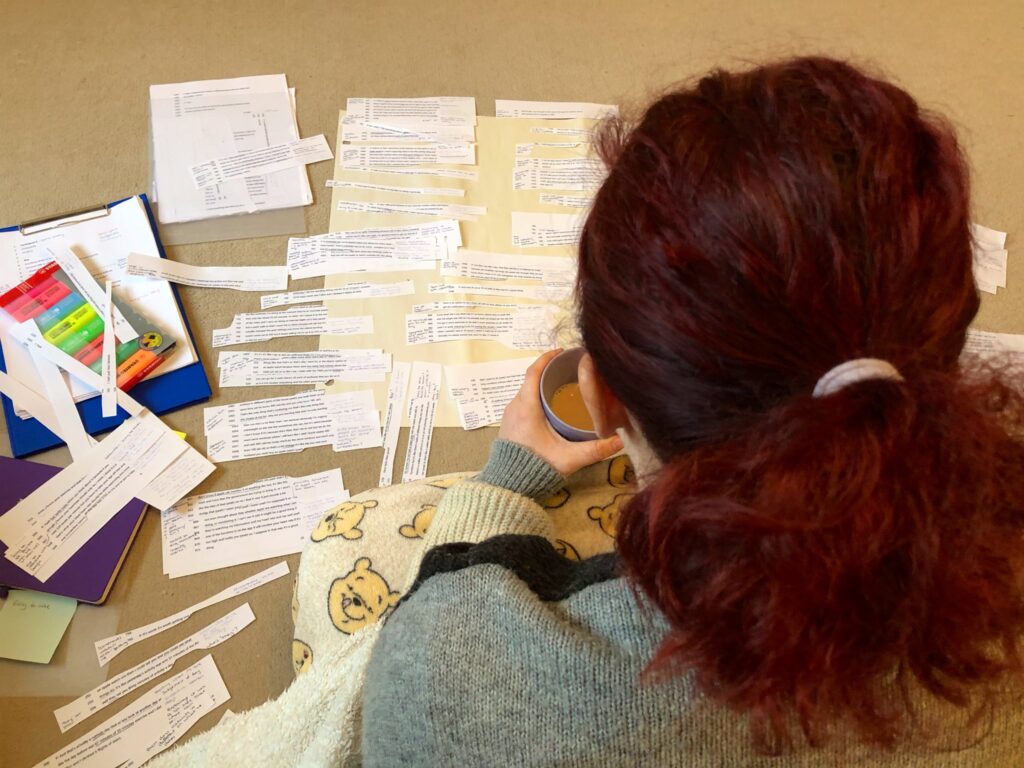
Thank you
Huge thank you to Esme Wood and Carol Percy, for sharing their thoughts on the IPA process.
Thank you for reading! I hope you have enjoyed my experiences of doing IPA. I would LOVE to hear about your experiences of doing IPA at any stage! Please don’t hesitate to get it touch if you have any questions comment below or contact me!

Brilliant blog Laura, thank you for sharing and for the photos (glad to see the rabbits helped!) It’s really great that you’ve been so clear and transparent about what you actually did, and it shows how much thought and interpretation went into this great piece of work. I’ve never done an IPA so can’t share my experience, but thank you again for sharing yours – it’s brilliant to know more about what it actually involves! Looking forward to seeing this great piece of work published 🙂
Thank you for your comment, Kate! I really appreciate your words and I’m glad you liked the post 🙂
Oh thank you, thank you so helpful as I am just about to start my analysis.
Sandra 🥰🥰
Hi Sandra! Thank you for your comment. I am glad it’s helful to you! Best of luck with your analysis 🙂 Laura
Thank you dear. So helpful
Hi Amina! Thanks for leaving a comment, I am glad it is helpful 🙂 Laura
Thank you so much for this post and especially the photos. I can actually see myself doing this through your descriptions and photos, and the bunny helps too. Best of luck with the rest of your process! ~Camille V.
Hi Camille! Thanks for leaving a comment. I am really glad you like the post and the photos (including the bunnies!) and hope they will be useful for your analysis. Laura 🙂
Thank you, Laura, It is very useful to read and learn.
Thank you so much for sharing your journey Laura. I am at the analysis stage of my PhD. I have interviewed 9 participants and have analyzed 6 using Smith’s et al 2009 edition of his book and following discussion with my supervisors I am going to use the new terminology from the second edition for the last three. Great pictures and this is how I plan to create my Group Experiential Themes.
BW,
Marina
Hi Marina, Thank you! I am glad you enjoyed the post and the pictures! Great work on getting 9 participants! Best of luck with the rest of your analysis 🙂 Laura
Found this super helpful and interesting to hear your reflections. I’m mid way through an IPA thesis and finding the mammoth task of analysis overwhelming!
Great to find this! I am doing IPA at the moment – I feel like I’m “on track” now!
I am just about to start analysis for my first PhD study and I can’t tell you how useful this blog post has been (especially the pictures). Thank you Laura!
Thanks Laura very much for your insights and experience. I am preparing my ethics application and this has really helped me. It is really good to hear some practical tips and photos are particularly helpful to visualise the process and see what this methodology entails. Your research sounds really interesting and it was good to see how your themes and subthemes emerged. I really like this approach to the research community sharing the real life aspects of research. Thanks, Chrissy
Hi Chrissy! Thank you for your comment and lovely words! I am glad it is helpful and all the best with your application! 🙂 Laura
Thank you for sharing this. I am about to start collecting data for IPA and trying to anticipate what I need to have in place for the analysis. I am trying to determine if I can do with software support and haven’t found anyone talking about doing it that way (I know Larkin doesn’t … lol). Have you seen that anywhere?
Hi Karen, Sorry, I haven’t heard of anything specific for IPA (personally I prefer to do by hand). I have used NVivo before for other qualitative research though. Best of luck with your search!
Thank you for sharing your experience. This is such an enormous help. Very clear and well put together. I have sent you a mail seeking some more information and wondered why I haven’t got a reply to date. I do hope you are receiving my comments.
Hi Margaret, I am glad this could be helpful to you and thank you for your emails. Best of luck with your project 🙂
Just started my IPA process with 7 interviews as well, and using your page as my ‘bible guide’ daily. What I wanted to know is how many themes in the end should/could you have? I am using IPA actually LIPA for one article at least for now for my PhD and as I’m now going through and making PETS, I see there could be upwards of 10 themes for the group, but feel that is too much especially with such a homogenized group.. any advice there?
Hi Regina, thank you for your question and email. I am really glad you are finding this post helpful! I have responded to your question via email – It is a very good question and one that is discussed a lot in the literature and IPA community. Good luck with your analysis 🙂
Thank you for sharing your experience, this is very helpful to me. I am currently doing data collection and analysis and I am using IPA. I hope to get in touch wit you for some moral support.
Thank you for sharing your experience, this is very helpful to me. I am currently doing data collection and analysis and I am using IPA. I hope to get in touch wit you for some moral support.
Is there a way to find out if ipa theme community group 56 is real on what ther do, its an investment ground for CLFV-Plus
garrey7@iCloud.com
This is all very insightful! Thank you
My supervisors are convinced I need to have a large number of participants because, as a PhD student, I have to have a large sample size regardless of what IPA says.
We’ve discussed this a lot, and well, now I have to do IPA for 26 transcipts, which I find overwhelming.
Would love to have more examples on some of the exploratory notes
Thank you so much for sharing your IPA journey and showing the steps so well delineated throughout. I am very new to qualitative research but have decided to embark on this journey for one of my PhD chapters as it complements my quant findings very nicely. I have my transcripts for 6 participants and have done the first set of exploratory notes.
Because my supervisor is quite insistent I use a qual software package-I have opted to use a blended approach of MS-word for that and exploratory notes and then export my experiential statements and code my PETs and subthemes in nvivo for the rest of the analysis.
I am very overwhelmed with creating this blended approach but let’s see.
I was looking at your exploratory notes section- mine are a bit more robust and I think that my experiential statements will be in sentence form. Do you think this is still ok? Or do you think this means I have to reduce my exploratory notes further? I am also having a difficult time understanding what is a conceptual note.
Any insights are welcome.
Thanks so much in advance!
Hey Laura,
Your experiences with IPA were both relatable and insightful. I have a question regarding your approach: Did you include all your PETs and Experiential Statements in your thesis, or did you focus primarily on GETs?
Kia ora Laura,
Thank you so much for such an honest and detailed blogpost. This gives so much reassurance for a new IPA researcher like myself. I am Apoorva Sriram, a PhD Student at the School of Psychology, Victoria University of Wellington, New Zealand. I have been trying to use NVIVO to engage in IPA. I am aware Smith et al.’s work encourages engaging with the paper-pencil method. One of my major challenges is organization and as a neurodivergent individual, using software helps me manage the organization of data to a good extent while I deep dive into interpretative work. I was wondering if you have come across anyone who used NVIVO for the analysis at all? I am having difficulty shifting from “Experiential statements” stage to creating “personal experiential themes” for each participant within the NVIVO project. If you have any pointers or leads at all? I’d love to hear from you.